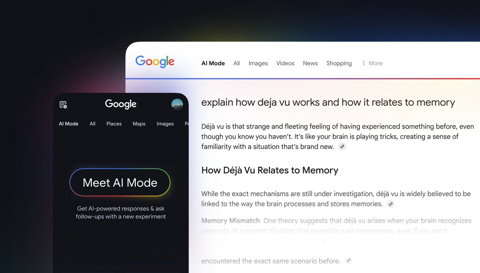Google AI Mode: What does it mean for SEO?

Google’s AI Mode is reshaping how people search, and what they see. Here’s what it means for your SEO strategy and how to stay visible in a changing landscape.
Google rolled out AI Mode in the US earlier this year, and with it came a significant shake-up to the way users search for information in the world's most popular search engine. Now, it has announced the roll out in the UK, but what does AI Mode mean for the future of search?
Will it be a nail in the coffin of the “SEO is dead” movement, or be a new way for Search Engine specialists to think about web visibility?
What is Google AI Mode?
AI Mode, initially launched as part of Google's Search Generative Experience (SGE) under Search Labs, is now being integrated as a default option for some users. Unlike AI Overviews, which overlay generative summaries within traditional SERPs, AI Mode presents a full-screen conversational interface, removing the classic ten blue links entirely. It’s being rolled out in the UK from the 29 July 2025, and will result in:
- A full AI interface, replacing classic SERPs and blue links with chatbot style outputs.
- The breakdown of complex queries into multiple sub questions with concurrent sub searches.
- Multimodal input options, such as text, voice, image and PDF uploads.

What can the US roll out tell us about the impact?
AI Mode was introduced in the US earlier in 2025, and we already have seen substantial impact on search behaviour and results, very similar to the impact of AI Overviews when it was launched in May 2024. From this, we can expect to see:
1. A reduction in clicks
In the US, many publishers and businesses have reported significant drops in organic click-through rates, with some citing a 30-70% decrease depending on the search query, according to BBC.
Furthermore, we can expect to see a continued rise in ‘zero click’ searches, since a substantial portion of Google searches now end without users clicking on any links. We can see this with AI Overviews which provide concise answers directly in the search results, negating the need to visit a website.
This presents a challenge in itself, with users potentially accessing inaccurate information that is compiled into an AI Overview, as Google itself admits that AI Overviews are not always 100% accurate.
2. Less importance of ‘top ranking’ pages
AI Mode does not necessarily favour the top 3 links on Google; it pulls information from a wide pool of sources including government sites, high-authority publishers, and frequently cited domains. While exact source lists are not transparent, early analysis suggests it prioritises consensus-backed, frequently crawled pages with clear authorship and structured data. So, your content could be featured, even if you’re not in the top position of traditional SERPs.
3. A shift in search behaviour
Users are interacting differently. Instead of typing “membership platform features,” they’re asking things like “What should I look for in a membership system for a charity?” AI Mode thrives on context-rich, nuanced prompts. As a result, traditional on-page keyword approaches may become less effective, and many news websites have reported significant declines in traffic as fewer people are directed to their site.
4. Fragmented reporting for the time being
AI Mode is experimental, and analytics are still catching up. US marketers noted challenges in tracking traffic sourced via AI responses, While Google Search Console hasn't yet surfaced AI Mode impressions or clicks (yet, although this is rolling out in the US), marketers are starting to track performance using server log analysis, scroll-depth metrics in GA4, and tools like Microsoft Clarity to infer user interaction trends.
What does AI Mode mean for you?
Keeping up with the speed of Google’s changes has been a marathon for any Search Specialist. But this latest introduction means that organisations should address some key things.
First, shift your reporting expectations. It's likely that traditional SEO metrics such as organic sessions and CTR will decline, which is a natural consequence of AI-first interfaces reducing direct traffic from SERPs. KPI expectations should shift away from clicks, and towards AI metrics such as AI Overview SERPs. Whilst still in their infancy, tools like LLMrefs or SEMrush are also beginning to track generative summary citations and AI response visibility, which can be used as a measure of success.
Second, put a greater emphasis on AIO & Content. AI still pulls its information from traditional search engine sources, so SEO tactics should continue to ‘get the basics of visibility’ right. This means solid technical foundations and trusted signals through strong EEAT content.
Content structure will continue to be important, if not more so. To appear in AI Mode answers, businesses must surface as trusted sources, with clear credentials. Where relevant, apply structured data such as FAQPage, HowTo, Article, and Product schema. Ensure markup is accurate and matches visible on-page content to improve eligibility for AI inclusion.
Ultimately, businesses will need to write content that AI wants to feature: and conversational search will become more important. One emerging challenge is that AI Mode may mention your brand or content without linking to it. Monitoring unlinked brand mentions through social listening platforms will become a key supplement to backlink tracking.
How to plan for the future of AI in Search
AI isn’t a new thing in search, but its significance continues to grow, and SEO continues to adapt. To stay ahead of the guessing-game, organisations can help by:
- Conducting content audits and optimisation: Rework pivotal pages to match conversational query structures, surface key information near the top of pages, and use relevant schema.
- Ensure content hierarchy: Turn cornerstone pages into conversational guides that AI Mode can reference more easily.
- Experimental monitoring: Track presence within AI responses for high value target queries. Build dashboards to monitor zero-click presence and align it to conversion outcomes.
- Google Business Profile: For organisations with physical locations, keeping the Google Business Profile and other directories up to date means that correct and current information will be referenced in AI Mode or AI Overviews, when generated for local search terms.
- Stay ahead of emerging mechanisms: LLMs.txt is a new standard proposed by some AI and SEO experts, that allow websites to opt in or out of being crawled by LLMs. It’s the AI sibling to robots.txt. Google hasn’t mandated it (yet) but its implementation will allow organisations to monitor and influence where websites appear in LLMs Outputs. For more information on controlling AI crawlers to your site, see our blog about the new Cloudflare settings.
Overall, AI mode is now about visibility within AI-generated answers, not just rankings. For our clients, it means a strategic pivot towards content built to be understood by AI, as well as trusted by users.